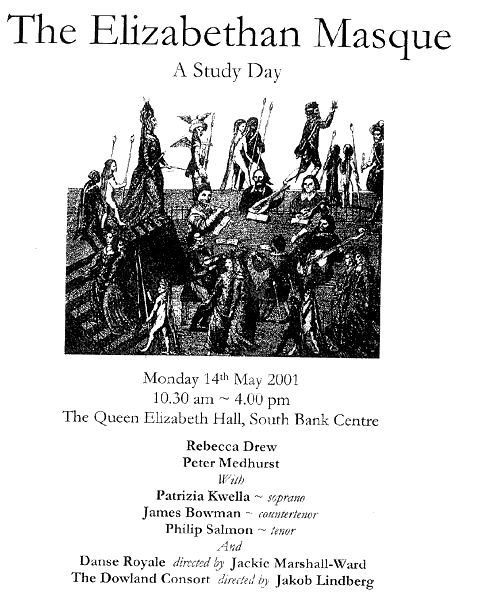
This very well attended event (QEH two-thirds full early on a Monday morning!) offered lectures followed by a thematic afternoon concert of early music, similar to one of those CDs often issued with a string of short songs and instrumental pieces, tied together by a historical situation (a wedding or a banquet perhaps) at which similar music might have been performed. The programme of Byrd, Morley, Dowland, and Italian composers of the period was hung on the peg of a memorial portrait in the National Portrait Gallery illustrating the life and death of Sir Henry Upton, soldier and 'educated musical gentleman', friend of John Dowland and ambassador to France for Queen Elizabeth, a man held in high esteem who was exceptionally well travelled for the times.
Art historian Rebecca Drew filled in the stormy political background and with winning enthusiasm analysed blown up details of the picture commissioned by Sir Henry's widow from an anonymous artist, leaving us all keen to visit the NPG to see the original.
Peter Medhurst introduced the instruments and players of The Dowland Consort (director, lutenist Jakob Lindberg) we were to hear after lunch, their 'broken consort' line-up illustrated in the picture's masque scene. We learnt that viols have a continuity right back to the 16th century - albeit only a 'small thread' through the 19th C. The (unkeyed) flute of the period has some of its chromatic notes weaker, so for more remote keys you change your flute (Bill Lyons). The pairing of English cittern (like a ukelele played with a plectrum - Jacob Henringman) with the bandora, which goes down to deep bass and 'knits the ensemble together' (Lynda Sayce), was particularly attractive. Peter Medhurst explained the decision not to 'mike' the music, telling us 'your ears will have to grow'. In that connection, Lindberg asserted that the lute relates to the human voice and is not a quiet instrument - 'all other instruments are much too loud'!
That was entirely vindicated by the intimacy of the afternoon concert, which drew in the audience, even those far back hearing easily and enjoying the unforced singing of the four eminent soloists, who blended perfectly with lute and consort. Seen&Heard has often (e.g. - - for live music making from the Indian sub-continent, the cause is all but lost? - - ) urged the same natural sound approach in smaller halls upon promoters of Indian music concerts; would they had been present to learn that lesson!)
Eight mature, light-footed ladies and gentlemen of the Danse Royale processed in and out in sumptuous, heavy Elizabethan costume and sat at a banqueting table. They gave additional pleasure and authenticity to the show by demonstrating decorous dances of the time, even risking daring lifts for the La Volta. I will not venture to describe how Dowland's A lesson for two to play on one lute was managed by Jakob Lindberg and Lynda Sayce, but it certainly put in the shade certain operatic music lessons!
The hour's music would make a good CD (or CD-ROM with the Unton picture) but the atmosphere would have been maintained better without applause after each short item, and if Rebecca Drew, who returned to read aloud an extract (printed in our programmes) from Queen Elizabeth's letter to the ailing Sir Henry, had done so simply, without donning her lecturing hat again to remind us that it was included to remind us in what great esteem Sir Henry Upton had been held. But it was a good event and promoters may well bear in mind that there is a potential day time audience to be wooed in the Capital.
This full day of Early Music at South Bank Centre moved to the Purcell Room for an uncommonly satisfying evening concert by Charivari Agréable, featuring two of the same players.
Peter Grahame Woolf
 Return to:
Return to: